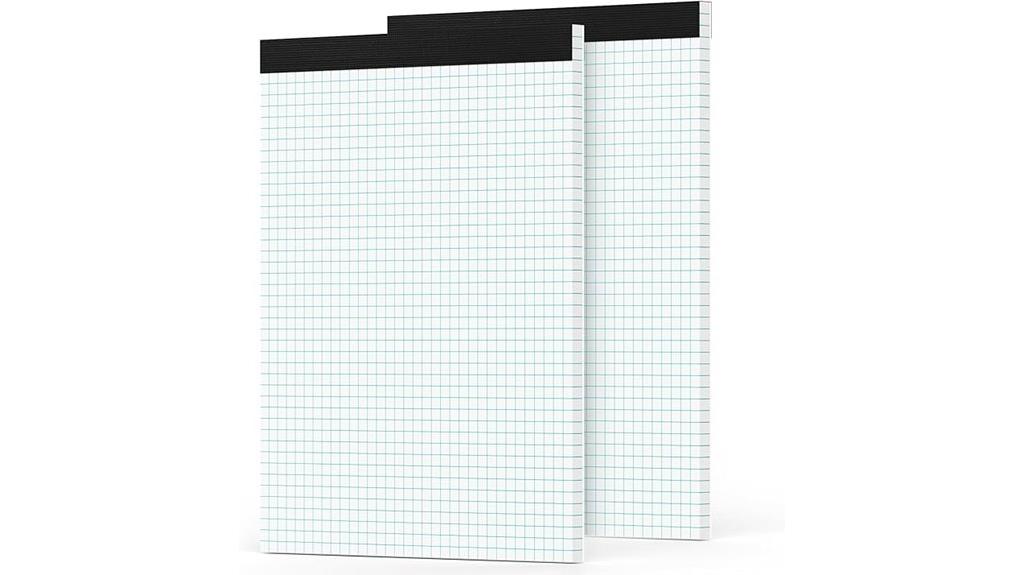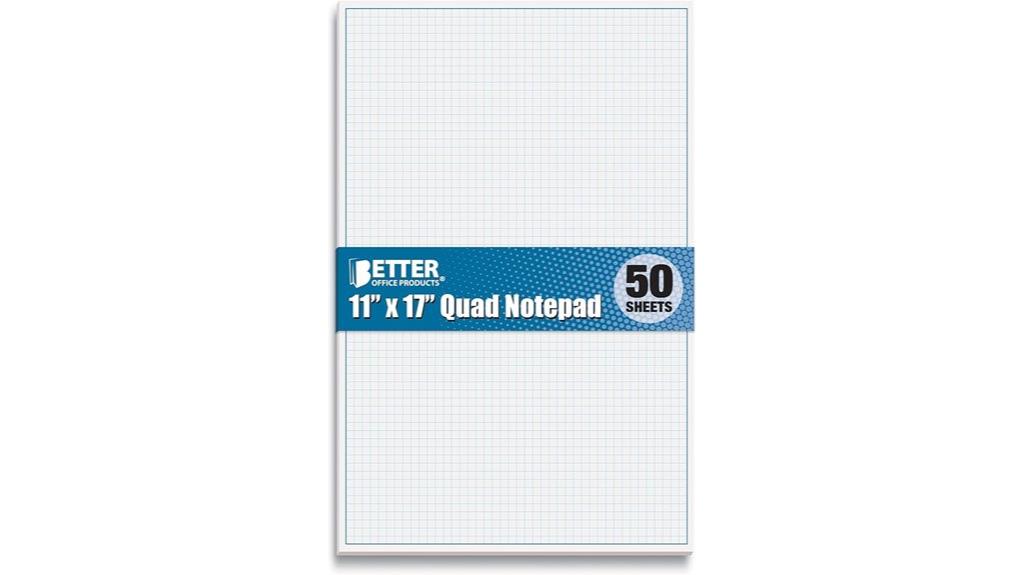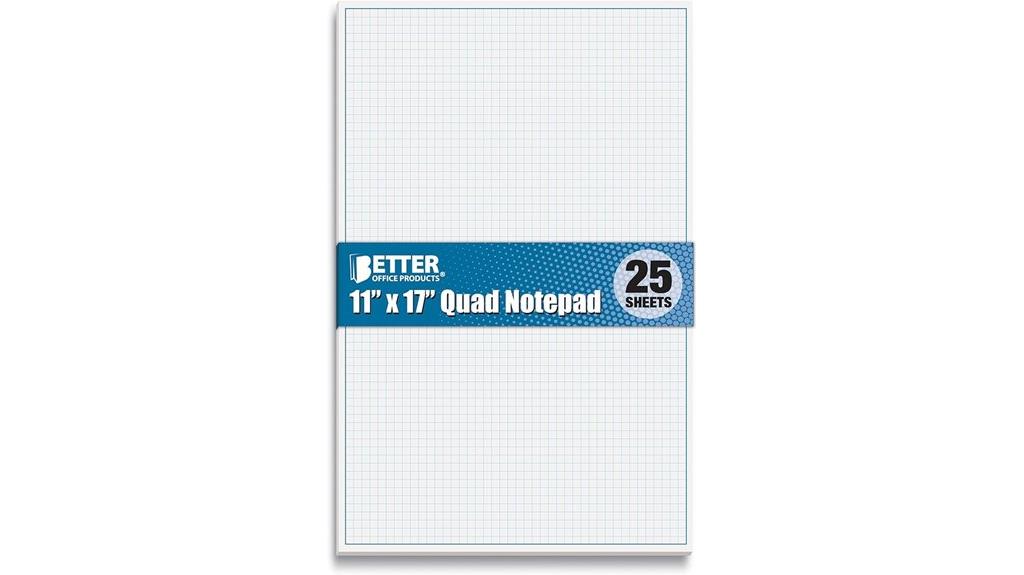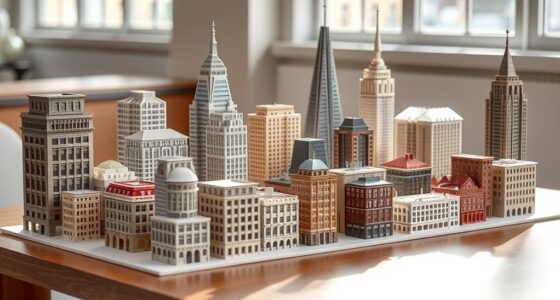If you’re looking for the best blueprint papers for architects and designers in 2025, I recommend exploring a mix of professional-grade wide format rolls, high-quality graph paper pads, and sturdy sketchbooks. I’ve found options like VOISEN and VEVOR rolls, large quadrille and engineering pads, and durable blueprint notebooks that suit various project needs. Keep in mind factors like paper durability, size, and compatibility with printers. Stay with me, and you’ll discover all the key details to make the right choice.
Key Takeaways
- Offers a diverse selection of blueprint notebooks, sketchbooks, and graph paper tailored for professional architects and designers.
- Features high-quality wide-format rolls and sheets compatible with inkjet printers and plotters for precise technical drawings.
- Emphasizes durable, bleed-resistant paper with micro perforations and sturdy backing for reliable, clean drafting.
- Includes specialized grid and isometric papers designed for schematics, engineering plans, and complex design projects.
- Balances portability and durability with options like hardcover notebooks and large-format rolls suitable for on-the-go and studio use.
Blueprint: Blue Graph Paper Notebook for Architectural Sketches and Design

If you’re an architect, engineer, or designer looking for a professional sketchbook that combines functionality with a classic blueprint aesthetic, the Blueprint: Blue Graph Paper Notebook is an excellent choice. It features blue front pages resembling authentic blueprints, paired with white grids for precise sketches and notes. The back pages are white, perfect for annotations or additional drawings. Designed for use with white ink pens, gel pens, and acrylic markers, it offers high contrast and clarity. With 100 pages in an 8.5 x 11-inch size, a durable cover, and secure binding, it’s ideal for on-the-go technical and artistic projects.
Best For: architects, engineers, designers, and creative professionals seeking a professional-grade blueprint-inspired sketchbook for technical drawings and artistic projects.
Pros:
- Features authentic blue blueprint front pages with white grids for precision.
- Suitable for use with white ink pens, gel pens, and acrylic markers for high contrast.
- Durable cover and secure binding make it portable for on-the-go use.
Cons:
- Limited to 100 pages, which may require frequent refilling for intensive projects.
- The blue front pages may not appeal to those preferring traditional white sketchbooks.
- Size (8.5 x 11 inches) might be bulky for some users needing a more compact sketchbook.
Graph Paper Pad 8.5 x 11, 2 Pack

The Graph Paper Pad 8.5 x 11, 2 Pack stands out as an excellent choice for students, engineers, and designers who need reliable, high-quality paper for technical sketches, notes, and detailed drawings. Each pad contains 30 sheets of crisp, 70 GSM paper with a 4×4 ruled grid (1/4 inch squares), resistant to ink bleed and suitable for both sides. The perforated sheets allow easy removal, and the sturdy backing provides stability for drafting without a desk. Praised for durability and affordability, these pads are perfect for complex technical work, math problems, and artistic sketches, making them a versatile addition to any professional or educational toolkit.
Best For: students, engineers, architects, and artists needing durable, high-quality graph paper for technical drawings, math work, and creative projects.
Pros:
- Resistant to ink bleed-through, suitable for both sides of the paper
- Perforated sheets allow for clean and easy removal without damage
- Sturdy backing provides stability for drafting and sketching on any surface
Cons:
- Grid lines may be too fine for users with larger handwriting or preference for bigger spacing
- Not explicitly marketed as fountain pen friendly, which may affect ink compatibility for some users
- Slightly heavier weight paper (70 GSM) might be more costly than standard notebooks for casual note-taking
Alliance Wide Format Paper 24 x 150 CAD Bond Rolls

Looking for reliable wide-format paper that handles technical drawings with precision? The Alliance Wide Format Paper 24 x 150 CAD Bond Rolls checks all the boxes. It’s a 20 lb, white, uncoated paper with a brightness rating of 92, designed specifically for CAD inkjet printing. Each roll measures 24 inches by 150 feet and comes in packs of four. Users praise its crisp, clean lines without bleed or smudges, making it ideal for architectural plans and drafts. Though it absorbs ink slowly, it offers excellent value, lays flat, and curls less than heavier papers. Overall, it’s a dependable choice for everyday CAD and drafting needs.
Best For: architects, engineers, and drafting professionals seeking reliable, high-quality wide-format paper for technical drawings and schematics.
Pros:
- Crisp, clean lines with no bleed or smudges, ensuring high-quality output
- Lays flat and curls less than heavier papers, making printing easier
- Suitable for daily use in CAD inkjet printing with consistent performance
Cons:
- Absorbs ink slowly, which may delay drying times for color-heavy prints
- Not suitable for high-density or heavy images requiring thicker paper
- Some users have noted the packaging could be more eco-friendly
Graph Paper Pad for Blueprint Drawings, Drafting, Engineering Drawing, and Planning

Designed for precision and durability, the Graph Paper Pad excels in supporting detailed blueprint drawings, engineering plans, and drafting projects. Its 11×17-inch high-brightness white paper features quadrille blue lines at 4 squares per inch, providing a clear grid for accurate sketches. With 50 thick sheets and a sturdy chipboard backing, it ensures stability during use. The binding on the short side makes flipping easy, while the generous drawing space—about 10.5”x16.5”—accommodates complex designs. Perfect for professionals and hobbyists alike, it’s versatile for everything from architectural plans to engineering schematics, making it a reliable, high-quality tool in any drafting arsenal.
Best For: professionals and hobbyists who require precise blueprint drawings, engineering plans, and detailed drafting on a large-format, durable graph paper pad.
Pros:
- High-quality, thick white paper with clear blue grid lines for accurate drawing.
- Sturdy chipboard backing provides stability during use, preventing warping or bending.
- Large 11×17-inch size offers ample space for detailed sketches and complex designs.
Cons:
- Bleed-through may occur with darker, permanent markers, limiting marker choices.
- Binding on the short side might be less convenient for some users accustomed to long-side binding.
- Limited to 50 sheets per pad, which may require frequent replacements for intensive projects.
Large Graph Paper Pad 11 x 17, Grid Paper, 4×4 Graph Ruled, Blueprint Quadrille Pad, 30 Sheets Engineering Paper, Drafting Paper, Graft Paper for Architect Engineer Designer Mathematician Draftsman

If you’re an architect, engineer, or designer seeking precise, large-format paper to bring your projects to life, the Large Graph Paper Pad 11 x 17 offers an ideal solution. With 4×4 grid squares printed in subtle blue lines, it helps maintain accuracy in drawings, charts, and sketches. The pad includes 30 double-sided sheets made from thick, bleed-resistant paper, perfect for pens, pencils, and markers. Micro perforations ensure clean tearing, and the reinforced backing adds durability for on-the-go use. Whether drafting blueprints or creating detailed diagrams, this pad provides ample space and quality to support professional, educational, and creative projects.
Best For: architects, engineers, designers, students, and artists who need large, precise grid paper for detailed drawings, blueprints, and creative projects.
Pros:
- High-quality, bleed-resistant thick paper suitable for multiple media including ink, pencil, and markers
- Large 11×17 inch format provides ample space for detailed diagrams and sketches
- Micro perforations allow easy, clean sheet removal for convenience and organization
Cons:
- Slightly thinner paper may cause minor ink bleed with markers for some users
- Heavier weight of the pad might be less portable for very on-the-go use
- Limited to a 4×4 grid pattern, which may not suit all grid or plotting preferences
ACYPAPER Plotter Paper 24 x 150, CAD Paper Rolls

ACYPAPER Plotter Paper 24 x 150 rolls stand out for professionals who need reliable, high-quality large-format printing. These rolls provide an impressive 24-inch by 150-foot length, perfect for continuous, uninterrupted output. With 80 GSM weight and a brightness of 96, they deliver sharp, vibrant images and detailed schematics. Compatible with various plotters and inkjet printers, they ensure seamless workflow for architects and engineers. Packaged in four-roll boxes, they offer easy storage and quick access, reducing downtime. Whether printing technical drawings or graphics, this paper supports precise, high-quality results essential for professional projects.
Best For: professionals in engineering, architecture, and design fields who require reliable, high-quality large-format printing for technical drawings, graphics, and schematics.
Pros:
- High brightness of 96 ensures vibrant, sharp images and text.
- Large 24 x 150-inch rolls provide extended, uninterrupted printing capacity.
- Compatible with various plotters and inkjet printers, ensuring seamless workflow.
Cons:
- At 80 GSM, the paper may be less suitable for very heavy or durable applications.
- Bulk packaging in four rolls may require ample storage space.
- Limited to large-format printing, not ideal for standard or smaller print jobs.
VOISEN Wide Format Paper, 4 Rolls, 36 In x 150 Ft, CAD Bond Paper

For architects and designers seeking reliable, high-quality wide format paper, VOISEN’s 4-roll set offers an excellent solution. Each roll measures 36 inches by 150 feet and features a 2-inch core compatible with most industry-standard inkjet printers. Made from premium CAD Bond paper with a brightness of 92, the sheets deliver sharp, vivid images and long-lasting durability. The smooth, uncoated surface guarantees accurate ink absorption, reducing smudges and jams during printing. These rolls support detailed plans, engineering drawings, and CAD projects, making them ideal for professional environments where precision, reliability, and clarity are essential.
Best For: architects, engineers, and designers who require reliable, high-quality wide format paper for technical drawings and CAD projects.
Pros:
- High-quality CAD Bond paper with excellent ink absorption for sharp, vivid images
- Compatible with most industry-standard inkjet printers, ensuring seamless use
- Durable and long-lasting, reducing print errors and smudging
Cons:
- May be slightly more expensive than generic wide format papers
- Requires proper storage to prevent moisture and damage over time
- Not ideal for applications requiring coated or specialty paper finishes
Sketchbook for Architects & Students with 5×5 Quad Ruled Graph Paper

A standout choice for architects and students seeking a portable sketching companion is the 5×5 quad-ruled graph paper sketchbook, which offers a convenient size of 8.5 x 11 inches and 110 pages. It’s well-made, affordable under $10, and highly rated. The white graph paper is perfect for quick sketches, project planning, and brainstorming ideas on the go. However, some users find the paper quality may tear easily, and pages don’t always remove cleanly, making it less ideal for detailed drawings. Overall, it’s a practical tool for capturing ideas quickly, though not suited for precise, finished work.
Best For: students, architects, and professionals looking for an affordable, portable sketchbook for quick sketches, brainstorming, and project planning on the go.
Pros:
- Well-made and highly rated for its affordability under $10.
- Convenient 8.5 x 11-inch size with 110 pages, easy to carry and use anywhere.
- Suitable for quick sketches, brainstorming, and idea jotting with quality white graph paper.
Cons:
- Pages may tear easily and do not always remove cleanly, limiting use for detailed drawings.
- Paper quality may be low, leading to potential tearing or damage during use.
- Not ideal for precise, finished drawings requiring clean page removal or high-quality paper.
VOISEN Wide Format Paper, 6 Rolls

If you’re looking for a reliable solution for large-format printing, VOISEN Wide Format Paper with 6 rolls stands out as an excellent choice. Each roll measures 24 inches by 150 feet, perfect for professional CAD and architectural prints. These high-quality paper rolls are compatible with standard printers, featuring a 2-core design for easy handling. They deliver sharp, vivid images with minimal smudging thanks to their premium moisture control and bright white surface. Ideal for engineering plans, architectural drawings, and CAD work, these rolls help maintain consistent, professional results while minimizing jams and disruptions. VOISEN offers a dependable, efficient option for busy design workflows.
Best For: professionals in engineering, architecture, and CAD design needing reliable, high-quality wide format printing solutions.
Pros:
- Compatible with all inkjet wide format printers for versatile use
- Maintains optimal moisture content for sharp, vivid images with minimal smudging
- Each roll’s size and design reduce printing disruptions and jams
Cons:
- May be more expensive than standard-sized or lower-quality paper options
- Requires compatible large-format printers, which might not be available in all offices
- Limited to applications requiring wide format plotter printing, not suitable for smaller projects
VEVOR Wide Format Paper, 24 in x 150 ft Plotter Paper

When selecting blueprint paper for large-scale architectural or engineering projects, precise and consistent printing matters most. I recommend the VEVOR Wide Format Paper, which offers four 24-inch by 150-foot rolls designed for high-volume printing. Its 80 g/m² weight ensures durability and smooth feeding, while the 2-inch core makes it compatible with most standard plotters. With high opacity up to 94%, double-sided printing is possible without bleed-through, and sharp, vibrant images are guaranteed thanks to pure wood pulp construction. It’s ideal for CAD drawings, plans, and maps, providing reliable performance and crisp results for professional presentations.
Best For: professionals in architecture, engineering, and GIS mapping who require reliable, high-quality large-format printing for blueprints, plans, and technical drawings.
Pros:
- Ensures precise, consistent cuts with machine-programmed length calculations.
- Supports double-sided printing with high opacity up to 94%, reducing bleed-through.
- Made from durable 80 g/m² pure wood pulp for sharp, vibrant, and clear images.
Cons:
- Requires compatible large-format plotter printers with 2-inch cores.
- May be more expensive than standard paper options for casual users.
- Handling four rolls simultaneously may require additional storage or organization space.
Graph Paper Pad, 17 x 11, 50 Sheets, Blue Line Border, Blueprint Paper

The Graph Paper Pad, 17 x 11 inches, with its durable blue line border and double-sided quadrille grid, consistently proves to be an essential tool for architects and designers who need reliable, high-quality blueprint paper. With 50 sheets per pad, it offers ample space for detailed sketches and technical drawings. The 4×4 quadrille grid ensures precision, while the thick blue borders help frame each design clearly. Its sturdy construction, including glued top-edge binding and a heavy backer board, guarantees durability and ease of use. Perfect for drafting, blueprints, or creative projects, this pad combines functionality with convenience. It’s a versatile choice from Better Office Products.
Best For: architects, engineers, and designers who need durable, high-precision blueprint paper for detailed technical drawings and drafting projects.
Pros:
- Heavy-duty construction with glued top-edge binding and heavy backer board for durability
- Clear 4×4 quadrille grid with thick blue border framing each sheet for precise, professional-looking drawings
- Double-sided printing maximizes usable space and value
Cons:
- Larger ledger size may be cumbersome for portable use or smaller workspaces
- Blue lines and borders may not be suitable for all types of projects or personal preferences
- Limited to 50 sheets per pad, which may require frequent replacements for intensive use
11 x 17 Quadrille Graph Paper (50 Sheets)

Designed for clarity on larger projects, the 11 x 17 Quadrille Graph Paper (50 Sheets) stands out as an ideal choice for architects and designers who need spacious, detailed blueprints and sketches. Its 0.25” blue dot grid with borders provides precise guidance for technical drawings, while the non-repro blue grid remains invisible in most scanners, ensuring clean reproductions. Made with high-brightness 20lb paper and supported by sturdy chipboard backing, these sheets are durable yet easy to handle. Perfect for drafting, engineering, or creative projects, this paper combines quality and functionality, supporting professionals and hobbyists alike in producing accurate, professional results.
Best For: architects, engineers, and professionals who need large, detailed blueprints and technical sketches on clear, durable paper.
Pros:
- Large 11 x 17 size ideal for detailed projects and presentations
- Non-repro blue grid ensures clean scans and reproductions
- High-quality 20lb bright paper with sturdy chipboard backing for durability
Cons:
- Larger size may be less portable for on-site use
- Limited to 50 sheets, which may require reordering for extensive projects
- Blue dot grid may not suit all drawing preferences or styles
Isometric Graph Paper 11×17, 50 Sheets

Looking for a reliable isometric graph paper that can handle detailed 3D visuals and technical diagrams? This 11×17-inch pad offers 50 sheets of high-quality, bright white, smooth paper, perfect for precise sketches. The professional isometric grid features 30°, 90°, and 120° angles, ideal for creating accurate technical drawings, geometric sketches, and 3D models. With a sturdy top glue binding, pages stay secure yet detach easily. Its large size supports expansive layouts, while the thick backing provides stability on desks. Suitable for engineers, architects, and designers, this paper guarantees professional results for both detailed drafting and creative projects.
Best For: engineers, architects, designers, and students needing precise, large-format isometric sketches and technical diagrams.
Pros:
- High-quality 80 gsm bright white paper resists smudging and bleed-through for professional results
- Large 11×17-inch sheets provide ample space for detailed drawings and layouts
- Secure top glue binding allows easy page removal while keeping pages secure during use
Cons:
- The large size may be less portable for on-the-go sketching
- Single-sided printing can limit reuse of both sides for notes or sketches
- Thick backing, while supportive, may add to the overall weight, making it less convenient for quick fieldwork
Better Office Products Graph Paper Pad, 17 x 11, 25 Sheets

If you’re seeking a reliable and versatile graph paper pad for professional drafting or creative projects, the Better Office Products Graph Paper Pad offers an excellent solution. Its ledger-sized 17 x 11-inch pages provide ample space for detailed drawings, with 25 double-sided sheets featuring a 4×4 quadrille grid. The blue lines on white paper, framed by a thick blue border, help maintain neatness. The glued top-edge binding and heavy backing board make it easy to tear sheets and work on large-format projects without slipping. Whether for engineering, blueprinting, or artistic sketches, this pad delivers durability and precision for your most demanding tasks.
Best For: professionals, students, and artists needing large-format, durable graph paper for precise drawings, drafting, and creative projects.
Pros:
- Large ledger-sized pages (17 x 11 inches) provide ample space for detailed work.
- Double-sided sheets with a 4×4 quadrille grid facilitate accurate drawing and planning.
- Thick backing board and glued top-edge binding ensure stability and easy tear removal.
Cons:
- Limited to 25 sheets, which may require frequent replacement for high-volume users.
- The blue border may be distracting for some detailed or color-sensitive projects.
- Not suitable for small-scale or fine detail work due to large grid size.
Large Engineering Graph Paper (22 x 17 Grid, 50 Sheets)

The Large Engineering Graph Paper (22 x 17 Grid, 50 Sheets) stands out as an essential tool for engineers, architects, and designers who need precise, large-format sheets for detailed technical drawings. Its 4×4 blue quad rule grid provides clarity and accuracy, ideal for blueprints, sketches, and calculations. Made from high-quality 100gsm acid-free paper, it resists ghosting and bleed-through, ensuring clean lines. The perforated sheets make removal easy, while the sturdy backer and triangle-bound corners protect your work. Whether for drafting, creative projects, or educational purposes, this paper offers versatility and durability, making it a valuable addition to any professional’s toolkit.
Best For: engineers, architects, designers, students, and professionals requiring precise large-format technical drawing and drafting work.
Pros:
- High-quality 100gsm acid-free paper resists ghosting and bleed-through for clean, professional results
- Large 22 x 17 inch sheets provide ample space for detailed sketches and blueprints
- Perforated sheets allow easy removal, and sturdy backer with triangle-bound corners protect work
Cons:
- The large size may be cumbersome for portable use or small workspaces
- Only 50 sheets included, which might be insufficient for extensive projects
- Blue quad grid may not suit all drawing or design preferences
Factors to Consider When Choosing Blueprint Paper

When selecting blueprint paper, I focus on factors like size compatibility and how well the grid lines show up. I also consider the paper’s durability and texture to make sure it holds up through handling and scanning. Ultimately, I weigh the ink compatibility, potential bleed-through, and overall cost to find the best fit for my project needs.
Paper Size Compatibility
Choosing the right blueprint paper size is vital to match your project needs and workflow. I always start by considering the project requirements—standard sizes like 8.5 x 11 inches or 11 x 17 inches work well for smaller sketches and details. For larger plans, wider formats such as 24 x 36 inches or even 150 inches are necessary to capture expansive layouts without splitting them across multiple sheets. It’s essential to verify that your printer or plotting device supports your chosen size to avoid jams or quality issues. Additionally, think about storage and handling—larger sizes require more space. Matching the paper size to your workflow ensures you can work efficiently, whether you’re producing quick concepts or detailed technical drawings.
Grid Line Visibility
Selecting the right grid line visibility on blueprint paper is key to creating accurate and legible drawings. I look for lines that are strong enough to guide my sketches without overpowering the design. If the grid lines are too faint, they’re hard to see during detailed work, which can compromise precision. On the other hand, overly dark lines distract from annotations and disrupt visual balance. The contrast between the lines and the background matters—blue lines on white or blue paper often work best for clarity. I also consider the thickness and intensity, using finer lines for intricate details and bolder lines for layout planning. Balancing these factors guarantees my drawings stay clear, precise, and easy to interpret.
Material Durability and Texture
Durability is essential when it comes to blueprint paper, as it needs to withstand frequent handling and environmental challenges without tearing or deteriorating. I recommend high-quality, heavy-weight materials like 20-80 GSM, which resist wear and tear over time. The texture of the paper also matters; smooth or slightly rough finishes influence ink adherence and prevent smudging during detailed work. Additionally, the paper’s resistance to moisture and environmental factors ensures the integrity of your drawings, even in humid or variable conditions. Choosing durable paper made from quality materials helps prevent ink bleed-through and feathering, keeping lines crisp and professional on both sides. The texture can also affect tool compatibility—smooth surfaces suit fine ink work, while rougher textures work better for broad marker strokes.
Ink Compatibility and Bleed-Through
When considering blueprint paper, it’s crucial to guarantee compatibility with your ink type to achieve clean, professional results. Using the right paper ensures your water-based, pigment, or solvent inks adhere properly without smudging or bleeding. I recommend choosing papers with a weight of at least 70 GSM, which helps with better ink absorption and reduces bleed-through. Coated or specially treated papers designed for technical printing are excellent choices, as they resist ink feathering and bleed. Before printing, I always test a small section to check how my ink interacts with the paper, preventing surprises later. If you print double-sided, opt for high-opacity papers to prevent ink from showing through on the reverse side. These considerations help maintain clarity and precision in your drawings.
Cost and Accessibility
Cost and accessibility are key factors to keep in mind when choosing blueprint paper, especially since these can considerably impact your project budget and workflow. The price varies depending on quality, size, and type, with larger rolls or specialized sheets costing more. Availability depends on local supply chains, stores, or online retailers—some types like CAD bond or engineering rolls are widely accessible, while others may be harder to find. Bulk purchasing can lower the per-sheet cost, making it more economical for large or ongoing projects. Regional demand and manufacturing locations also influence both price and availability. Ensuring the paper meets industry standards is essential, but balancing quality with budget constraints helps streamline your process and keeps costs manageable.
Frequently Asked Questions
What Environmentally Friendly Blueprint Paper Options Are Available?
I recommend using recycled or sustainably sourced blueprint papers, which reduce environmental impact. Brands now offer FSC-certified options made from post-consumer waste or bamboo pulp, both of which are eco-friendly. These papers perform well for detailed drawings and are biodegradable. Switching to these options not only helps the planet but also aligns with green building principles, making your work more sustainable without sacrificing quality.
How Does Paper Weight Affect Blueprint Durability?
Paper weight considerably impacts blueprint durability. Heavier papers, like 24-28 lb, are more resistant to tearing and handling, ensuring your plans stay intact over time. Lighter papers may rip or wrinkle more easily, risking damage during transport or use. I recommend selecting a weight that balances durability with ease of handling, especially for detailed or large-scale projects, to keep your blueprints looking professional and protected.
Are There Specific Papers Suited for 3D Modeling Sketches?
Ever wonder what makes 3D modeling sketches stand out? I find that smooth, heavyweight papers like bristol or vellum are perfect because they handle detailed shading and multiple erasures without tearing. These papers act like a canvas for your creativity, offering durability and precision. If you want your sketches to truly shine and last, choose materials that support your artistic process and bring your ideas to life with clarity.
Can Certain Papers Enhance Ink or Marker Longevity?
Absolutely, certain papers can enhance ink and marker longevity. I prefer smooth, acid-free papers with a coated surface, like marker or illustration papers, because they prevent feathering and fading over time. Using quality papers helps my ink and markers stay vibrant longer, ensuring my sketches remain sharp and professional. If you’re serious about preserving your work, investing in the right paper makes all the difference in durability and appearance.
What Are the Best Storage Practices for Blueprint Papers?
I recommend storing blueprint papers in a cool, dry place away from direct sunlight to prevent fading and damage. Keep them flat or rolled loosely to avoid creases. Use acid-free folders or tubes for added protection, and handle them with clean hands to prevent dirt or oil transfer. Regularly check on your files to guarantee they stay in good condition for long-term use.
Conclusion
Choosing the right blueprint paper can truly elevate your architectural projects. Did you know that engineers and architects report a 30% boost in drawing accuracy when using quality-grade blueprint papers? By selecting the best paper for your needs, you guarantee precision and clarity in your designs. So, take your time, consider your specific requirements, and watch your ideas come to life with confidence and professionalism. Your perfect blueprint paper awaits—happy designing!









